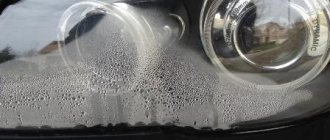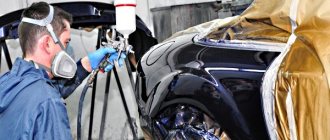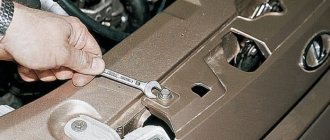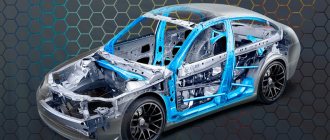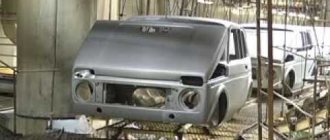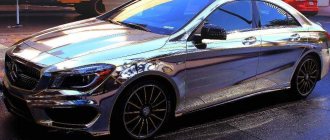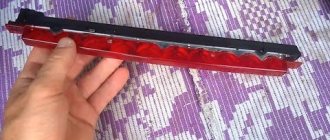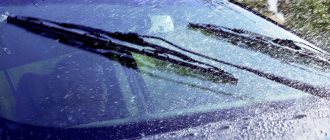Repairing through body corrosion is a serious problem that specialists from the Professional network of auto body stations successfully cope with. Are you driving an old car that was produced when the body was not yet galvanized? Did you miss the beginning of the appearance of rust and brought the situation to a critical level? Dont be upset. We will repair car body corrosion quickly and inexpensively.
Attention!!! In most cases, welding work can be abandoned. The problem is solved by processing and using high-quality materials - fiberglass putties. Of course, if we are talking about a load-bearing frame - racks, cross members, spars - it is optimal to use welding technology. For tail surfaces (wings, doors, wheel arches), durable repairs can be achieved without it.
We suggest that you find out the price for repairing through body corrosion in advance. Send your photo to: This email address is being protected from spambots. You must have JavaScript enabled to view. We will conduct a remote assessment, send an estimate to your email or call. Leave your contact phone number.
Causes and places of rust on a car body
Rust is the oxidation of metal that occurs under the influence of air, water and static electricity. Therefore, the main reason for its occurrence is damage to the paintwork of the car body. Microcracks and physical damage allow air and moisture to reach the iron. The speed of the destructive impact will depend on the degree of protection of the body itself and the aggressiveness of the environment. This is especially true in winter, when many chemicals appear on our roads.
The above factors directly affect the shape, color and depth of corrosion. People call them differently: “saffron milk caps,” “bugs,” or simply “rusty spots,” but their essence is the same (only the degree of neglect varies). A single spot of rust is easier to deal with than many small red spots. The latter usually indicates poor quality metal or unsuccessful body repairs. The total processing area will be larger. Moreover, these points often spread in depth rather than in breadth. Blistering of the paint also signals the need to remove corrosion that has begun to develop under the paintwork.
The most common places for bugs and rust spots (photo)
Thresholds Arches Wings at the arches Trunk
Rust progresses well in places where there is increased exposure to foreign objects: sand, dirt, stones. The hood suffers from small stones from the tires of other cars, the wheel arches from their own “emissions” (by the way, wide non-standard tires or rims contribute to greater damage). The thresholds of the car are also one of the first to rot due to the close proximity to the “aggressive environment”, plus unsuccessful exits from curbs aggravate the situation.
Content
- What is “red disease” and why does it occur?
- How to remove “saffron milk caps” with your own hands Stage 1. Cleaning the body of “saffron milk caps”
- Stage 2. Puttying the car body
- Stage 3. Body painting
Corrosion is dangerous because it violates the integrity of the body. This makes the car less safe and puts the lives of the driver and passengers at risk.
In this material we will tell you what causes the “red” disease, where it most often appears, how to get rid of it and what cars are affected by it.
How to delete: options
We have become acquainted with the causes and places, let's move on to methods of correct elimination. There are two methods that differ in the way they remove rust:
- Mechanical - cleaning, priming, puttying, painting.
- Chemical - rust converters or kits for galvanizing metal.
You cannot do without the first method if the rust is strongly ingrained into the metal. Then it is necessary to completely eliminate traces of corrosion until pure iron (ideally shiny) remains. To do this, you may need additional tools and resources, which we will discuss below in step-by-step instructions. The second option is suitable for hard-to-reach places. These could be curves on the bottom of the car or the inside of the arches, which are difficult to process using mechanical means. Depending on the product, rust after chemical treatment can turn into foam (you need to rinse with water and dry the surface) or harden and become covered with a protective layer suitable for painting. Be sure to read the instructions and recommendations for the use of chemicals before purchasing. Before starting work, try to assess the extent of damage to the body and assess whether you can etch the damage with chemicals alone. For a positive result, it is necessary that “live” iron remains after the initial cleaning. If there are through holes or the final thickness of the metal after processing is too small, then more serious body repairs will be needed, that is, initially all these areas will need to be repaired using welding or putty with fiberglass.
Fiberglass rust through repair
Glass mat with resin can be considered as an alternative way to repair a completely rusted body panel. It can be used instead of welding a metal patch. The disadvantage is that glass mat, unlike welding a metal patch, does not impart structural rigidity to the metal. Additionally, metal and fiberglass have different expansion/contraction rates. This limits where it can be used and the size of holes that can be repaired this way. If stress is transferred to a fiberglass repaired body panel, the repair area may crack and peel off. Small holes (less than 8 cm in diameter) on the body panel can be repaired with glass mat and resin if everything is done correctly. The advantage of such repairs is accessibility for the car enthusiast and the absence of heat, which occurs during welding and worsens the anti-corrosion properties of the metal.
For spot rust through, if the metal around the hole is not rusty, metal tinning and soldering technology can be used. You can read more about this at the end of the article “Tinning and soldering the body”.
Auto body repair shops often sell fiberglass and polyester resin kits. The disadvantage of this resin is its strong shrinkage after complete hardening and poor adhesion to metal. If possible, it is better to use epoxy resin. It has less shrinkage and adheres better to metal. Repairs with epoxy resin will be more reliable.
Repairing small holes (less than 8 cm) on a body panel with fiberglass and resin:
- Sand the panel area to be repaired down to bare metal with 16-24 grit sandpaper. It is necessary to clean the paint with a margin of 10–15 cm around the repaired area.
- The remaining rusty metal must be cut out so that only clean metal remains.
- It is better to deepen the repair area (the edges of the hole with a small margin) so that the fiberglass does not rise above the general surface.
- Cut the glass mat 3 cm larger than the hole to be repaired.
- Apply resin mixed with hardener to the area to be repaired.
- After some time, glue the glass mat to the surface and saturate it with resin.
- For repairs, 2 or 3 layers of glass mat can be used, which must be applied sequentially, after hardening and sanding the previous layer.
- After the resin has hardened, the surface must be sanded and putty applied.
The reverse side of the repair area also needs to be treated and protected from rust.
Reviews of the most popular tools and methods
The ideal option is orthophosphoric acid. Apply a thin layer to the camelina, wait 10–30 seconds, wipe dry with a cotton pad. It eats up rust and forms a phosphate film that is not afraid of water and is inert.
Maxim Leonov
https://avto-flot.ru/blog/kak-udalit-rjavchinu-s-kuzova-avtomobilya-i-ostanovit-ee-rasprostranenie.html
I already tried orthophosphorus - this is still an old-fashioned method, I processed what I cleaned. (As far as I know, all these inhibitors and converters are what it is, only in multi-colored bottles). Indeed, almost cleaned surfaces, this rubbish gets rid of rust residues. But untouched, so to speak, terry thickets of corrosion do not particularly react to it. So, they sizzle a little, darken, turn pale and remain in place.
Saf
https://forums.drom.ru/4×4/t1151267034.html
Nowadays, people no longer burn at the stake for the magic of transforming rust into pure and white metal, but a miraculous transformation does not happen either. And the zealous body workers continue to sand, etch, putty, treat with filler... And that’s why - because you can’t pull it out without difficulty... It’s impossible, you know, to rub it with a cloth and for it to become overgrown - it doesn’t happen. So go ahead, Shura, go ahead...
Zaika 2106
https://forum.auto.ru/chemistry/22048/
Car body soldering
This method is used to seal small and large holes without welding. To work, you will need flux, which will protect the metal from rapid oxidation. Soldering acid, sold in radio stores, can successfully cope with this task. To achieve the required temperature, you will need a soldering iron with a power of 1 kW or more, or a version heated with a blowtorch, but it is better to use a gas torch. The solder is chosen to be refractory, since it can be used to repair a hole in the car body more reliably.
Small holes are simply filled with solder, starting from the edges and gradually fusing to the center. A large hole in the body is covered with a patch cut from tin from a tin can. It provides:
- strong connection, almost like welding;
- significantly longer service life than putty, but less than welding;
- possibility of sealing large holes;
- ease of implementation, repairs are accessible even to beginners.
The work is performed in the following sequence:
- A patch is cut to fit the size of the hole. The larger the area of contact with the body, the more reliable the connection.
- The soldered edges of the patch and the damaged areas are cleaned with sandpaper until shiny.
- Using flux and solder, the cleaned surfaces are tinned.
- After applying the patch to the repaired area of the car, it is heated to the melting temperature of the solder. In this case, you need to ensure the continuity of the seam so that there are no missing sections.
- After cooling, the remaining flux is removed, and the soldering area is washed with hot water and soda.
Please note!
The disadvantage of this method is that the patch swells due to heating. If checking with a ruler confirms this, the bubble is removed with light blows of a hammer.
The resulting depression is leveled with putty:
- Marks are applied to the surface of the patch, plus a few millimeters from each edge, with 120-grit sandpaper. This is necessary for reliable adhesion of the putty to the metal.
- The cleaned surface is cleaned of dust and degreased with a solvent.
- To prevent the metal from becoming rusty, the primer is applied no later than an hour after preparation.
- The first 2 layers are applied with a phosphate or acid primer with an interval of 15 minutes.
- After waiting another quarter of an hour, apply 2 - 3 layers of acrylic primer at intervals of 5 minutes.
- It takes 3 - 4 hours to dry completely. The drying process can be accelerated using an infrared heater.
Do-it-yourself chemical way to get rid of corrosion
The chemical method differs only in the initial stage - cleaning the part from rust. According to reviews from manufacturers, these substances are able to eradicate rust, stop its further spread and do not damage the iron itself (unlike “sandpaper”). Application is very simple - apply the product to the rusty surface for 30-40 minutes, then wipe with a cloth or rinse with water. But to get a nice, smooth surface you will still have to clean, putty and polish (except for the initial stages of corrosion).
Some funds are available to motorists even with the most modest budget
There are kits on sale that allow you to independently apply a protective layer of zinc to the car body. The kit already contains a solution for removing rust and applying a protective layer, as well as an electrode with a zinc tip. This process is electrochemical, so a connection to a battery is required.
The kit includes liquids and all necessary working tools
Stages of emergence
Rust usually occurs after an accident. But under normal conditions it is a natural process characterized by three stages:
- at the first stage, car corrosion affects the joints of parts - it is eliminated with sandpaper or other improvised means;
- the second stage is known as “subfilm” - it is manifested by an emerging lesion surrounded by swollen paint;
- the third stage is characterized by damage to the metal body and the appearance of holes in it - such damage to the metal can be eliminated with the help of a full restoration of the body.
To prevent the first stage from flowing into subsequent ones, the car is periodically inspected for chips, impacts, and changes in paint color. If you notice early when rust damage begins, you can prevent serious problems.
How to remove “saffron milk caps” and “bugs”
Many people want to believe that if rust has just appeared and the lesions are small, then they can be eliminated with some miracle remedy. Unfortunately, this is impossible in principle. The rust that appears on the surface of the paintwork is like the tip of an iceberg; the main damage is deep inside.
There are products on sale that will help remove the red color from the body. For example, there is Anti-Rust paste - it removes red spots quite quickly and well. This is the same rust converter that we discussed above. It eliminates the visible signs, but not the source itself. Such manipulations usually last for 2–6 weeks (depending on weather conditions), and they are most often used immediately before selling the car.
Small “bugs” sometimes cause big problems for the car seller!
If you want to get rid of the problem in the long term, then you cannot do without physical intervention. It is necessary to stop the access of air and moisture directly to the metal. Theoretically, you can prolong the effect of the paste if, after treatment, you cover the damaged area of the body with clear varnish. But it will work if the converter has managed to remove all the rust. In most cases, this does not happen, since the depth of penetration of the product is small.
Unfortunately, it will not be possible to hide damage for a long time only with the help of paste.
Helpful information
In order for the process of removing rust from the body to be successful, you need to adhere to the following recommendations:
- All work must be carried out taking into account safety precautions. Hands are protected with gloves, and eyes with special glasses.
- When treating the body with caustic substances, you need to take care of high-quality ventilation in the room.
- You cannot keep acid on the surface of the body for too long; it can destroy intact metal.
You can learn about various methods and techniques for removing rust from a car here.
Prevention
Corrosion can be prevented. Sometimes it is possible to mitigate its consequences. Many motorists are unaware of this or ignore simple rules.
To prevent rust formation, do the following:
- The bottom is treated with anti-corrosion agents.
- Clean and wash the car. They do this regularly. Winter is no exception. This removes aggressive substances from the surface that lead to corrosion. For the same purpose, they are treated with wax.
- Protects the car coating from stones. Place an anti-gravel film on the hood. They also protect other parts of the car, such as the roof. Installed above the windshield. A “fly swatter” is suitable as a protection option.
- Don't forget about mudguards and fender liners. Equipped with all four wheels.
- The car is inspected periodically. The earlier stains are noticed, the easier it is to deal with them.
Fighting rust is a common job for car enthusiasts. Don't delay with her. "Saffron milk caps" are spreading quickly. This treatment helps protect the car and avoid expensive repairs. Usually you can do everything yourself.
